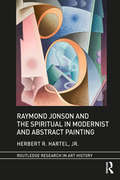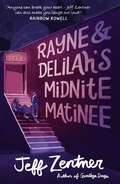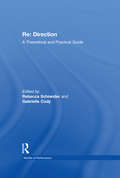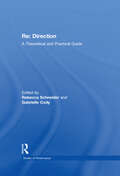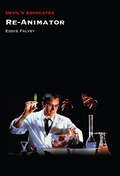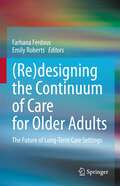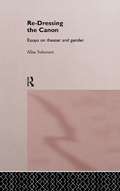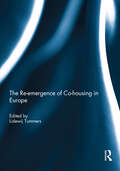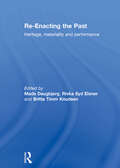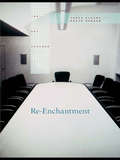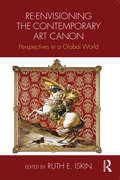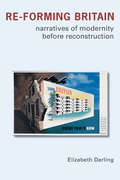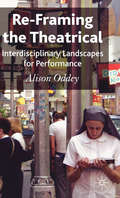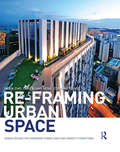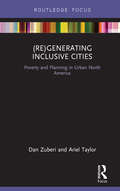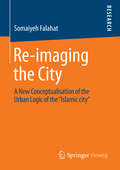- Table View
- List View
Raymond Jonson and the Spiritual in Modernist and Abstract Painting (Routledge Research in Art History)
by Herbert R. Hartel, Jr.This is the most thorough and detailed monograph on the artwork of Raymond Jonson. He is one of many artists of the first half of the twentieth-century who demonstrate the richness and diversity of an under-appreciated period in the history of American art. Visualizing the spiritual was one of the fundamental goals of early abstract painting in the years before and during World War I. Artists turned to alternative spirituality, the occult, and mysticism, believing that the pure use of line, shape, color, light and texture could convey spiritual insight. Jonson was steadfastly dedicated to this goal for most of his career and he always believed that modernist and abstract styles were the most effective and compelling means of achieving it.
Rayne and Delilah's Midnite Matinee
by Jeff ZentnerJosie and Delia are best friends and co-hosts on their own public access TV show, Midnite Matinee. They dress as vampires Rayne and Delilah, perform daft skits involving skeleton raves and dog weddings, and show the weekly so-bad-it's-good low-budget horror movie. But the end of senior year is coming, and Josie is torn between pursuing her television dreams in a new city or staying making TV with her BFF. What's more, she's just met a boy, Lawson, who is totally not her type, but is just a little bit intriguing . . . Meanwhile, Delia is searching for her dad, who walked out on her and her mom ten years ago. When the private investigator she hired unearths his contact details, she agonises over digging up the past.A road trip to ShiverCon, a convention for horror filmmakers, may just have the answers the two need - but will Josie and Delia be prepared for life taking some seriously unexpected plot-twists?
Re: A Theoretical and Practical Guide (Worlds of Performance)
by Gabrielle Cody Rebecca SchneiderRe: Direction is an extraordinary resource for practitioners and students on directing. It provides a collection of ground-breaking interviews, primary sources and essays on 20th century directing theories and practices around the world. Helpfully organized into four key areas of the subject, the book explores: * theories of directing * the boundaries of the director's role * the limits of categorization * the history of the theatre and performance art. Exceptionally useful and thought-provoking introductory essays by editors Schneider and Cody guide you through the wealth of materials included here. Re: Direction is the kind of book anyone interested in theatre history should own, and which will prove an indispensable toolkit for a lifetime of study.
Re: A Theoretical and Practical Guide (Worlds of Performance)
by Gabrielle Cody Rebecca SchneiderRe: Direction is an extraordinary resource for practitioners and students on directing. It provides a collection of ground-breaking interviews, primary sources and essays on 20th century directing theories and practices around the world. Helpfully organized into four key areas of the subject, the book explores: * theories of directing * the boundaries of the director's role * the limits of categorization * the history of the theatre and performance art. Exceptionally useful and thought-provoking introductory essays by editors Schneider and Cody guide you through the wealth of materials included here. Re: Direction is the kind of book anyone interested in theatre history should own, and which will prove an indispensable toolkit for a lifetime of study.
Re-Animator (Devil's Advocates)
by Eddie FalveySince its release at the mid-point of the 1980s American horror boom, Stuart Gordon’s Re-Animator (1985) has endured as one of the most beloved cult horror films of that era. Greeted by enthusiastic early reviews, Re-Animator has maintained a spot at the periphery of the classic horror film canon. While Re-Animator has not entirely gone without critical attention, it has often been overshadowed in horror studies by more familiar titles from the period. Eddie Falvey’s book, which represents the first book-length study of Re-Animator, repositions it as one of the most significant American horror films of its era. For Falvey, Re-Animator sits at the intersection of various developments that were taking place within the context of 1980s American horror production. He uses Re-Animator to explore the rise and fall of Charles Band’s Empire Pictures, the revival of the mad science sub-genre, the emergent popularity of both gore aesthetics and horror-comedies, as well as a new appetite for the works of H.P. Lovecraft in adaptation. Falvey also tracks the film's legacies, observing not only how Re-Animator’s success gave rise to a new Lovecraftian cycle fronted by Stuart Gordon, but also how its cult status has continued to grow, marked by sequels, spin-offs, parodies and re-releases. As such, Falvey's book promises to be a book both about Re-Animator itself and about the various contexts that birthed it and continue to reflect its influence.
Re-Animator (Devil's Advocates)
by Eddie FalveySince its release at the mid-point of the 1980s American horror boom, Stuart Gordon’s Re-Animator (1985) has endured as one of the most beloved cult horror films of that era. Greeted by enthusiastic early reviews, Re-Animator has maintained a spot at the periphery of the classic horror film canon. While Re-Animator has not entirely gone without critical attention, it has often been overshadowed in horror studies by more familiar titles from the period. Eddie Falvey’s book, which represents the first book-length study of Re-Animator, repositions it as one of the most significant American horror films of its era. For Falvey, Re-Animator sits at the intersection of various developments that were taking place within the context of 1980s American horror production. He uses Re-Animator to explore the rise and fall of Charles Band’s Empire Pictures, the revival of the mad science sub-genre, the emergent popularity of both gore aesthetics and horror-comedies, as well as a new appetite for the works of H.P. Lovecraft in adaptation. Falvey also tracks the film's legacies, observing not only how Re-Animator’s success gave rise to a new Lovecraftian cycle fronted by Stuart Gordon, but also how its cult status has continued to grow, marked by sequels, spin-offs, parodies and re-releases. As such, Falvey's book promises to be a book both about Re-Animator itself and about the various contexts that birthed it and continue to reflect its influence.
(Re)designing the Continuum of Care for Older Adults: The Future of Long-Term Care Settings
by Farhana Ferdous Emily RobertsThis book broadens the visioning on new care environments that are designed to be inclusive, progressive, and convergent with the needs of an aging population. The contents cover a range of long-term care (LTC) settings in a single collection to address the needs of a wide audience.Due to the recent COVID-19 pandemic, rethinking the spatial design of care facilities in order to prepare for future respiratory and contagious pathogens is one of the prime concerns across the globe, along with social connectedness and autonomy in care settings. This book contributes to the next generation of knowledge and understanding of the growing field of the design of technology, programs, and environments for LTC that are more effective in infection prevention and control as well as social connectedness. To address these issues, the chapters are organized in four sections: Part I: Home- and community-based care; Part II: Facility-based care; Part III: Memory care and end-of-life care; and Part IV: Evidence-based applied projects and next steps. (Re)designing the Continuum of Care for Older Adults: The Future of Long-Term Care Settings is an essential resource for researchers, practitioners, educators, policymakers, and students associated with LTC home and healthcare settings. With diverse topics in theory, substantive issues, and methods, the contributions from notable researchers and scholars cover a range of innovative programming, environments, and technologies which can impact the changing needs and support for older adults and their families across the continuum of care.
Re-Dressing the Canon: Essays on Theatre and Gender
by Alisa SolomonRe-Dressing the Canon examines the relationship between gender and performance in a series of essays which combine the critique of specific live performances with an astute theoretical analysis. Alisa Solomon discusses both canonical texts and contemporary productions in a lively jargon-free style. Among the dramatic texts considered are those of Aristophanes, Ibsen, Yiddish theatre, Mabou Mines, Deborah Warner, Shakespeare, Brecht, Split Britches, Ridiculous Theatre, and Tony Kushner. Bringing to bear theories of 'gender performativity' upon theatrical events, the author explores: * the 'double disguise' of cross-dressed boy-actresses * how gender relates to genre (particularly in Ibsens' realism) * how canonical theatre represented gender in ways which maintain traditional images of masculinity and femininity.
Re-Dressing the Canon: Essays on Theatre and Gender
by Alisa SolomonRe-Dressing the Canon examines the relationship between gender and performance in a series of essays which combine the critique of specific live performances with an astute theoretical analysis. Alisa Solomon discusses both canonical texts and contemporary productions in a lively jargon-free style. Among the dramatic texts considered are those of Aristophanes, Ibsen, Yiddish theatre, Mabou Mines, Deborah Warner, Shakespeare, Brecht, Split Britches, Ridiculous Theatre, and Tony Kushner. Bringing to bear theories of 'gender performativity' upon theatrical events, the author explores: * the 'double disguise' of cross-dressed boy-actresses * how gender relates to genre (particularly in Ibsens' realism) * how canonical theatre represented gender in ways which maintain traditional images of masculinity and femininity.
The re-emergence of co-housing in Europe
by Lidewij TummersAcross Europe, the number of co-housing initiatives is growing, and they are increasingly receiving attention from administrators and professionals who hold high expectations for urban liveability. Is co-housing a marginal idealist phenomenon, or the urban middle class’ answer to the current housing crisis? And has the development of theoretical insight and research kept up with the actual expansion of co-housing as a practice? These questions were raised during the first European conference on co-housing research, which took place in Tours, France, in March 2012. Both the conference and this book aim to move beyond case-studies, and to look more particularly at the implications and wider perspective of the current co-housing trend.Using the specific vocabulary of different disciplines and geographic regions, the contributions to this book analyse the underlying thinking behind, and the expectations projected on, diverse models of collaborative housing. The authors are aware of the qualities of contemporary co-housing, but they go beyond advocacy to investigate the conditions under which co-housing can be successful as a strategy for housing provision; can offer solutions for sustainable urban development; or indeed can contribute to involuntary or intentional gentrification. This book was originally published as a special issue of the Journal of Urban Research and Practice.
The re-emergence of co-housing in Europe
by Lidewij TummersAcross Europe, the number of co-housing initiatives is growing, and they are increasingly receiving attention from administrators and professionals who hold high expectations for urban liveability. Is co-housing a marginal idealist phenomenon, or the urban middle class’ answer to the current housing crisis? And has the development of theoretical insight and research kept up with the actual expansion of co-housing as a practice? These questions were raised during the first European conference on co-housing research, which took place in Tours, France, in March 2012. Both the conference and this book aim to move beyond case-studies, and to look more particularly at the implications and wider perspective of the current co-housing trend.Using the specific vocabulary of different disciplines and geographic regions, the contributions to this book analyse the underlying thinking behind, and the expectations projected on, diverse models of collaborative housing. The authors are aware of the qualities of contemporary co-housing, but they go beyond advocacy to investigate the conditions under which co-housing can be successful as a strategy for housing provision; can offer solutions for sustainable urban development; or indeed can contribute to involuntary or intentional gentrification. This book was originally published as a special issue of the Journal of Urban Research and Practice.
Re-Enacting the Past: Heritage, Materiality and Performance
by Mads Daugbjerg Rivka Syd Eisner Britta Timm KnudsenWhat is re-enactment and how does it relate to heritage? Re-enactments are a ubiquitous part of popular and memory culture and are of growing importance to heritage studies. As concept and practice, re-enactments encompass a wide range of forms: from the annual ‘Viking Moot’ festival in Denmark drawing thousands of participants and spectators, to the (re)staged war photography of An-My Lê, to the Titanic Memorial Cruise commemorating the centennial of the ill-fated voyage, to the symbolic retracing of the Berlin Wall across the city on 9 November 2014 to mark the 25th anniversary of its toppling.Re-enactments involve the sensuousness of bodily experience and engagement, the exhilarating yet precarious combination of imagination with ‘historical fact’, in-the-moment negotiations between and within temporalities, and the compelling drive to re-make, or re-presence, the past. As such, re-enactments present a number of challenges to traditional understandings of heritage, including taken-for-granted assumptions regarding fixity, conservation, originality, ownership and authenticity. Using a variety of international, cross-disciplinary case studies, this volume explores re-enactment as practice, problem, and/or potential, in order to widen the scope of heritage thinking and analysis toward impermanence, performance, flux, innovation and creativity.This book was originally published as a special issue of the International Journal of Heritage Studies.
Re-Enacting the Past: Heritage, Materiality and Performance
by Mads Daugbjerg, Rivka Syd Eisner and Britta Timm KnudsenWhat is re-enactment and how does it relate to heritage? Re-enactments are a ubiquitous part of popular and memory culture and are of growing importance to heritage studies. As concept and practice, re-enactments encompass a wide range of forms: from the annual ‘Viking Moot’ festival in Denmark drawing thousands of participants and spectators, to the (re)staged war photography of An-My Lê, to the Titanic Memorial Cruise commemorating the centennial of the ill-fated voyage, to the symbolic retracing of the Berlin Wall across the city on 9 November 2014 to mark the 25th anniversary of its toppling.Re-enactments involve the sensuousness of bodily experience and engagement, the exhilarating yet precarious combination of imagination with ‘historical fact’, in-the-moment negotiations between and within temporalities, and the compelling drive to re-make, or re-presence, the past. As such, re-enactments present a number of challenges to traditional understandings of heritage, including taken-for-granted assumptions regarding fixity, conservation, originality, ownership and authenticity. Using a variety of international, cross-disciplinary case studies, this volume explores re-enactment as practice, problem, and/or potential, in order to widen the scope of heritage thinking and analysis toward impermanence, performance, flux, innovation and creativity.This book was originally published as a special issue of the International Journal of Heritage Studies.
Re-Enchantment (The Art Seminar)
by James Elkins David MorganThe near-absence of religion from contemporary discourse on art is one of the most fundamental issues in postmodernism. Artists critical of religion can find voices in the art world, but religion itself, including spirituality, is taken to be excluded by the very project of modernism. The sublime, "re-enchantment" (as in Weber), and the aura (as in Benjamin) have been used to smuggle religious concepts back into academic writing, but there is still no direct communication between "religionists" and scholars. Re-Enchantment, volume 7 in The Art Seminar Series, will be the first book to bridge that gap. The volume will include an introduction and two final, synoptic essays, as well as contributions from some of the most prominent thinkers on religion and art including Boris Groys, James Elkins, Thierry de Duve, David Morgan, Norman Girardot, Sally Promey, Brent Plate, and Christopher Pinney.
Re-Enchantment (The Art Seminar)
by James Elkins David MorganThe near-absence of religion from contemporary discourse on art is one of the most fundamental issues in postmodernism. Artists critical of religion can find voices in the art world, but religion itself, including spirituality, is taken to be excluded by the very project of modernism. The sublime, "re-enchantment" (as in Weber), and the aura (as in Benjamin) have been used to smuggle religious concepts back into academic writing, but there is still no direct communication between "religionists" and scholars. Re-Enchantment, volume 7 in The Art Seminar Series, will be the first book to bridge that gap. The volume will include an introduction and two final, synoptic essays, as well as contributions from some of the most prominent thinkers on religion and art including Boris Groys, James Elkins, Thierry de Duve, David Morgan, Norman Girardot, Sally Promey, Brent Plate, and Christopher Pinney.
Re-envisioning the Contemporary Art Canon: Perspectives in a Global World
by Ruth E IskinRe-envisioning the Contemporary Art Canon: Perspectives in a Global World seeks to dissect and interrogate the nature of the present-day art field, which has experienced dramatic shifts in the past 50 years. In discussions of the canon of art history, the notion of ‘inclusiveness’, both at the level of rhetoric and as a desired practice is on the rise and gradually replacing talk of ‘exclusion’, which dominated critiques of the canon up until two decades ago. The art field has dramatically, if insufficiently, changed in the half-century since the first protests and critiques of the exclusion of ‘others’ from the art canon. With increased globalization and shifting geopolitics, the art field is expanding beyond its Euro-American focus, as is particularly evident in the large-scale international biennales now held all over the globe. Are canons and counter-canons still relevant? Can they be re-envisioned rather than merely revised? Following an introduction that discusses these issues, thirteen newly commissioned essays present case studies of consecration in the contemporary art field, and three commissioned discussions present diverse positions on issues of the canon and consecration processes today. This volume will be of interest to instructors and students of contemporary art, art history, and museum and curatorial studies.
Re-envisioning the Contemporary Art Canon: Perspectives in a Global World
by Ruth E IskinRe-envisioning the Contemporary Art Canon: Perspectives in a Global World seeks to dissect and interrogate the nature of the present-day art field, which has experienced dramatic shifts in the past 50 years. In discussions of the canon of art history, the notion of ‘inclusiveness’, both at the level of rhetoric and as a desired practice is on the rise and gradually replacing talk of ‘exclusion’, which dominated critiques of the canon up until two decades ago. The art field has dramatically, if insufficiently, changed in the half-century since the first protests and critiques of the exclusion of ‘others’ from the art canon. With increased globalization and shifting geopolitics, the art field is expanding beyond its Euro-American focus, as is particularly evident in the large-scale international biennales now held all over the globe. Are canons and counter-canons still relevant? Can they be re-envisioned rather than merely revised? Following an introduction that discusses these issues, thirteen newly commissioned essays present case studies of consecration in the contemporary art field, and three commissioned discussions present diverse positions on issues of the canon and consecration processes today. This volume will be of interest to instructors and students of contemporary art, art history, and museum and curatorial studies.
Re-forming Britain: Narratives of Modernity before Reconstruction
by Elizabeth DarlingRe-forming Britain considers the nature and practice of architectural modernism in inter-war Britain in a new light. Bringing hitherto little considered protagonists and projects to the fore, it argues that rather than being an imported idiom, the new architecture in Britain formed part of an ongoing attempt to make a modern nation. Spanning the period 1925-42, the book focuses on the key sites from and through which architectural modernism emerged in the UK. Part one considers the main arena in which a will to modernize Britain developed in the 1920s. In parts two and three the author documents, contextualizes and explains how this modernizing will was given modernist form, discussing the work of architects such as Wells Coates, Maxwell Fry, and Connell and Ward, and their allied ventures with likeminded reformers in other fields. These collaborations produced ‘narratives of modernity’: buildings, projects, exhibitions and books, through which, the book argues, modernist reformers were able to persuade politicians, and those with influence upon them, that modernism was the means to re-form the nation. Re-forming Britain offers the first in-depth analysis of well-known modernist schemes such as Kensal House and the Pioneer Health Centre but also brings previously little studied or unknown activities to light. This important work invites a new understanding of the nature of architectural modernism in inter-war Britain and the ways in which it ultimately gave form to post-war Britain.
Re-forming Britain: Narratives of Modernity before Reconstruction
by Elizabeth DarlingRe-forming Britain considers the nature and practice of architectural modernism in inter-war Britain in a new light. Bringing hitherto little considered protagonists and projects to the fore, it argues that rather than being an imported idiom, the new architecture in Britain formed part of an ongoing attempt to make a modern nation. Spanning the period 1925-42, the book focuses on the key sites from and through which architectural modernism emerged in the UK. Part one considers the main arena in which a will to modernize Britain developed in the 1920s. In parts two and three the author documents, contextualizes and explains how this modernizing will was given modernist form, discussing the work of architects such as Wells Coates, Maxwell Fry, and Connell and Ward, and their allied ventures with likeminded reformers in other fields. These collaborations produced ‘narratives of modernity’: buildings, projects, exhibitions and books, through which, the book argues, modernist reformers were able to persuade politicians, and those with influence upon them, that modernism was the means to re-form the nation. Re-forming Britain offers the first in-depth analysis of well-known modernist schemes such as Kensal House and the Pioneer Health Centre but also brings previously little studied or unknown activities to light. This important work invites a new understanding of the nature of architectural modernism in inter-war Britain and the ways in which it ultimately gave form to post-war Britain.
Re-Framing the Theatrical: Interdisciplinary Landscapes for Performance
by A. OddeyOddey questions the role of the spectator and director, and the nature of art works and performance. She provocatively demonstrates the spectator as centre of the artistic experience, a new kind of making theatre-art, revealing its spirit and nature; searching for space and contemplation in a hectic twenty-first century landscape.
Re-Framing Urban Space: Urban Design for Emerging Hybrid and High-Density Conditions
by Im Sik Cho Chye-Kiang Heng Zdravko TrivicRe-framing Urban Space: Urban Design for Emerging Hybrid and High-Density Conditions rethinks the role and meaning of urban spaces through current trends and challenges in urban development. In emerging dense, hybrid, complex and dynamic urban conditions, public urban space is not only a precious and contested commodity, but also one of the key vehicles for achieving socially, environmentally and economically sustainable urban living. Past research has been predominantly focused on familiar models of urban space, such as squares, plazas, streets, parks and arcades, without consistent and clear rules on what constitutes good urban space, let alone what constitutes good urban space in ‘high-density context’. Through an innovative and integrative research framework, Re-Framing Urban Space guides the assessment, planning, design and re-design of urban spaces at various stages of the decision-making process, facilitating an understanding of how enduring qualities are expressed and negotiated through design measures in high-density urban environments. This book explores over 50 best practice case studies of recent urban design projects in high-density contexts, including Singapore, Beijing, Tokyo, New York, and Rotterdam. Visually compelling and insightful, Re-Framing Urban Space provides a comprehensive and accessible means to understand the critical properties that shape new urban spaces, illustrating key design components and principles. An invaluable guide to the stages of urban design, planning, policy and decision making, this book is essential reading for urban design and planning professionals, academics and students interested in public spaces within high-density urban development.
Re-Framing Urban Space: Urban Design for Emerging Hybrid and High-Density Conditions
by Im Sik Cho Chye-Kiang Heng Zdravko TrivicRe-framing Urban Space: Urban Design for Emerging Hybrid and High-Density Conditions rethinks the role and meaning of urban spaces through current trends and challenges in urban development. In emerging dense, hybrid, complex and dynamic urban conditions, public urban space is not only a precious and contested commodity, but also one of the key vehicles for achieving socially, environmentally and economically sustainable urban living. Past research has been predominantly focused on familiar models of urban space, such as squares, plazas, streets, parks and arcades, without consistent and clear rules on what constitutes good urban space, let alone what constitutes good urban space in ‘high-density context’. Through an innovative and integrative research framework, Re-Framing Urban Space guides the assessment, planning, design and re-design of urban spaces at various stages of the decision-making process, facilitating an understanding of how enduring qualities are expressed and negotiated through design measures in high-density urban environments. This book explores over 50 best practice case studies of recent urban design projects in high-density contexts, including Singapore, Beijing, Tokyo, New York, and Rotterdam. Visually compelling and insightful, Re-Framing Urban Space provides a comprehensive and accessible means to understand the critical properties that shape new urban spaces, illustrating key design components and principles. An invaluable guide to the stages of urban design, planning, policy and decision making, this book is essential reading for urban design and planning professionals, academics and students interested in public spaces within high-density urban development.
(Re)Generating Inclusive Cities: Poverty and Planning in Urban North America
by Dan Zuberi Ariel Judith TaylorAs suburban expansion declines, cities have become essential economic, cultural and social hubs of global connectivity. This book is about urban revitalization across North America, in cities including San Francisco, Toronto, Boston, Vancouver, New York and Seattle. Infrastructure projects including the High Line and Big Dig are explored alongside urban neighborhood creation and regeneration projects such as Hunters Point in San Francisco and Regent Park in Toronto. Today, these urban regeneration projects have evolved in the context of unprecedented neoliberal public policy and soaring real estate prices. Consequently, they make a complex contribution to urban inequality and poverty trends in many of these cities, including the suburbanization of immigrant settlement and rising inequality. (Re)Generating Inclusive Cities wrestles with challenging but important questions of urban planning, including who benefits and who loses with these urban regeneration schemes, and what policy tools can be used to mitigate harm? We propose a new way forward for understanding and promoting better urban design practices in order to build more socially just and inclusive cities and to ultimately improve the quality of urban life for all.
(Re)Generating Inclusive Cities: Poverty and Planning in Urban North America
by Dan Zuberi Ariel Judith TaylorAs suburban expansion declines, cities have become essential economic, cultural and social hubs of global connectivity. This book is about urban revitalization across North America, in cities including San Francisco, Toronto, Boston, Vancouver, New York and Seattle. Infrastructure projects including the High Line and Big Dig are explored alongside urban neighborhood creation and regeneration projects such as Hunters Point in San Francisco and Regent Park in Toronto. Today, these urban regeneration projects have evolved in the context of unprecedented neoliberal public policy and soaring real estate prices. Consequently, they make a complex contribution to urban inequality and poverty trends in many of these cities, including the suburbanization of immigrant settlement and rising inequality. (Re)Generating Inclusive Cities wrestles with challenging but important questions of urban planning, including who benefits and who loses with these urban regeneration schemes, and what policy tools can be used to mitigate harm? We propose a new way forward for understanding and promoting better urban design practices in order to build more socially just and inclusive cities and to ultimately improve the quality of urban life for all.
Re-imaging the City: A New Conceptualisation of the Urban Logic of the “Islamic city”
by Somaiyeh FalahatSomaiyeh Falahat investigates the spatial and morphological logic of pre-modern Middle Eastern and North African cities, so-called “Islamic cities”. She bases her argument on the fact that the city and consequently its form and structure, similar to other human products, have deep roots in the thought-structure of the people. Thus, to know such places properly, one has to refer to this life-world and use it as a structure to observe the city. This approach aims at opening new levels of understanding of the city by grasping indigenous concepts and structures; it puts forward claims for the possibility of a new method of analysis. The author studies the historic city of Isfahan as the case study and suggests that an indigenous term, Hezar-Too, can explain the complexity of the city, which has been interpreted as labyrinthine and maze-like accounting for the essence of the city and its form in an appropriate way. Looking at the city from this new point of view can help in observing it in its context and subsequently in discovering its real character.
